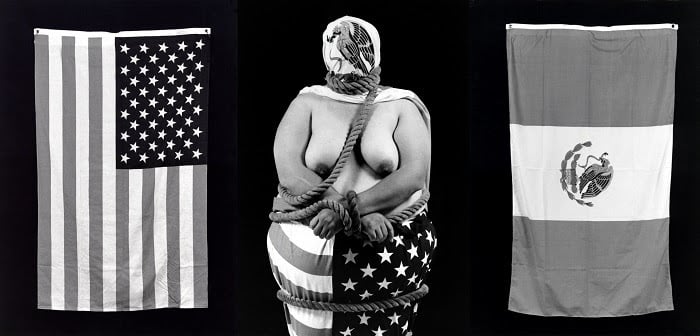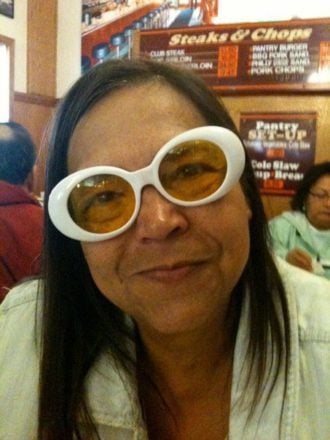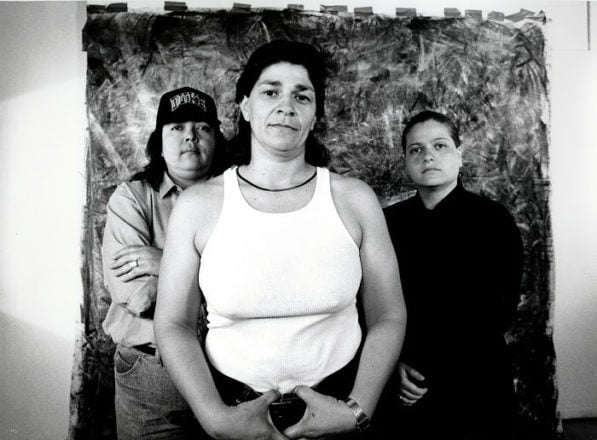
Laura Aguilar is well known for her iconic triptych “Three Eagles Flying.” Featuring her signature self-portraiture, the artist’s nude body takes on a form of rebellion against the colonization of Latinx identities – racial, gendered, cultural and sexual. Photo: Laura Aguilar, “Three Eagles Flying,” 1990. Three gelatin silver prints. Courtesy of the artist and the UCLA Chicano Studies Research Center.
The LGBTQ community is mourning the loss of queer Latinx photographer Laura Aguilar, the trailblazing artist whose 1992 images captured the working class, lesbian residents of East Los Angeles who found sanctuary at the iconic dyke bar the Plush Pony.
‘SHE WAS A BADASS’
“The beautiful, dynamic queer Chicana photographer Laura Aguilar has died,” performance artist Monica Palacios posted on Facebook. “She was a trailblazer. She was a badass. Laura documented so much of our queer Latinx LA lives during the 90s. Rest in power magnificent Laura.”
Aguilar died early Wednesday at a hospice care facility in Long Beach from complications related to diabetes, said Christopher Anthony Velasco, her agent and one of the trustees of her estate.
Aguilar was 58, Velasco said.
A celebration will take place, but the details have not yet been confirmed, Velasco said.
Glenn Burke, baseball’s first openly gay player, helped create high five
RETROSPECTIVE EXHIBIT
Aguilar, who was born and resided in San Gabriel, recently was the subject of a career retrospective, “Laura Aguilar: Show and Tell,” at the Vincent Price Art Museum in Monterey Park, and her photography appeared last year in the two-part exhibition “Axis Mundo: Queer Networks in Chicano L.A.” The shows, part of the Pacific Standard Time: LA/LA series of exhibitions, helped bring her art to a new audience.
Aguilar’s retrospective, which spans three decades of her career and features more than 130 photographs, is on view at the Frost Art Museum in Miami.

As a woman of color, a lesbian, and auditory and reading comprehension dyslexic, Laura Aguilar (seen in a 2016 photo) used photography as an outlet and a way to explore and challenge notions of identity, the female body, and societal assumptions about beauty. Photo: Luis Alfaro.
Aguilar’s health had been deteriorated, but was determined to see her retrospective exhibit open, Velasco said.
“Laura was having a lot of health issues, but she was holding on to see her show,” he said. “Laura wanted to see her show. She was so happy when she saw it.”
Aguilar was the daughter of a Mexican-U.S. father and a Mexican-Irish mother. As a woman of color, a lesbian, and auditory and reading comprehension dyslexic, Aguilar used photography as an outlet and a way to explore and challenge notions of identity, the female body, and societal assumptions about beauty.
Aguilar studied photography at East Los Angeles Community College and participated in Santa Fe Photographic Workshops, but mostly considered herself self-taught.
‘LAURA WAS A FIRECRACKER’
“Laura was an intense, sweet, and difficult person,” Velasco said. “She was stubborn, but thoughtful and super intelligent.
“Laura was a firecracker,” he said. “She could bust your balls, but when it came time for studio visit or lecture for students, she loved to talk with students and talk about photography.”
Aguilar’s work has been exhibited in the 1993 Venice Biennale, the Los Angeles City Hall Bridge Gallery, Los Angeles County Museum of Art, the Hammer Museum, the Smithsonian Institution’s International Gallery, and the International Center of Photography in New York City.
Aguilar’s work is important for its intersections across her identities: queer, brown, feminist, and Latinx.
Among the works showcased in “Laura Aguilar: Show and Tell” is “Three Eagles Flying,” a powerful black-and-white portrait of the artist standing bare-breasted and tied with rope between the United States and Mexican flags. Aguilar looks as if she is stuck in limbo between between the two countries.

Laura Aguilar was a trailblazing photographer, whose 1992 images captured the working class, lesbian residents of East Los Angeles who found sanctuary at the iconic dyke bar the Plush Pony. Photo: Laura Aguilar, “Plush Pony #2,” 1992. Gelatin silver print.
Courtesy of the artist and the UCLA Chicano Studies Research Center.
LESBIAN BAR PHOTOS
The exhibit also spotlights several series of works, including 1992’s “Plush Pony Series” that documents the working-class regulars at the Plush Pony lesbian bar in East Los Angeles, and “Nude Self-Portraits,” photographs of Aguilar lying among the desert terrain and natural rock formations in New Mexico.
On Facebook, Marie Cartier, a senior lecturer in gender and women’s studies at Cal State Northridge and film and media studies at UC Irvine, said, “Aguilar’s work opened up for me the world of East Los Angeles and the iconic dyke bar the Plush Pony. Her gaze was authentic and revelatory.
“May that lost lesbian bar space be open again and crowded on the other side tonight. May the drinks be cold. And may the ‘Last Dance’ always …be a sweet one.”
Aguilar is survived by her nephew, Michael Aguilar.
